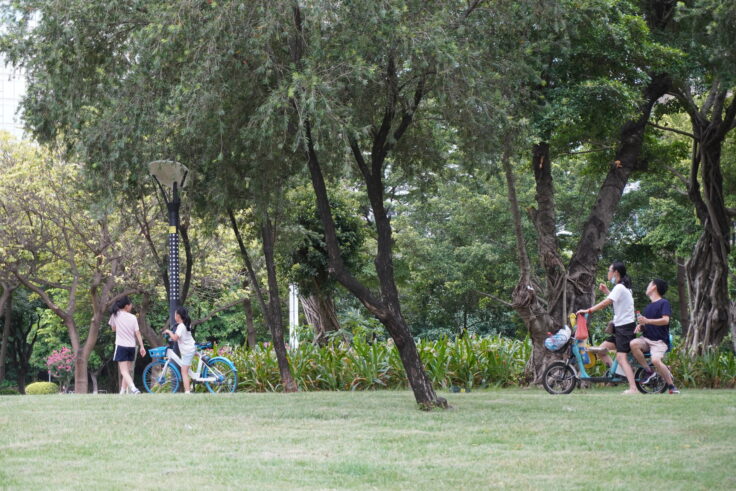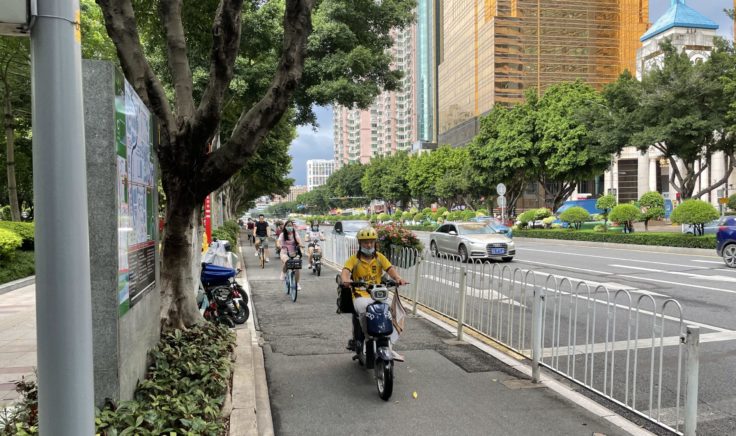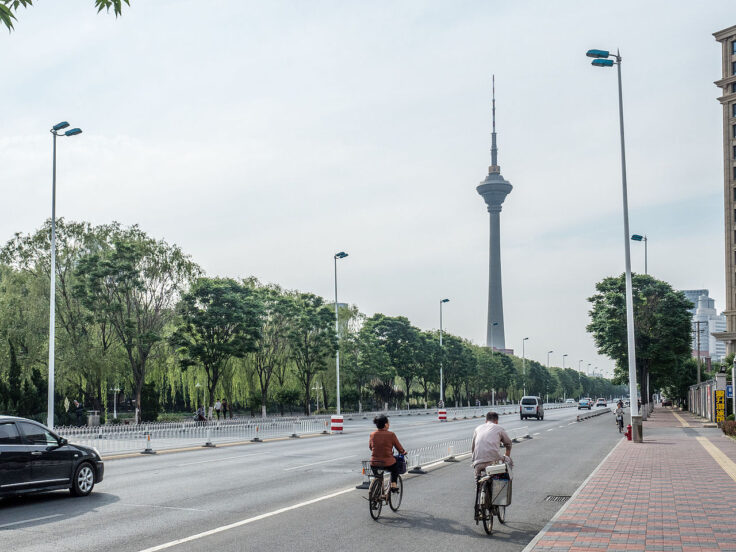September 30, 2023
These Major Chinese Cities Are Making Moves On Cycling
What does the future of ‘cycling cities’ look like for China, what unique challenges do they face, and how are some cities already taking action?
This article, developed with ITDP China, is the third in a three-part series highlighting the past, present, and future of urban cycling as a means for promoting sustainable and active mobility across China.
Given China’s unique history with cycling and the surging demand for affordable mobility options, city governments have been ramping up efforts to create more cycling and pedestrian-friendly environments. These efforts are being driven by central policy directives on climate and sustainability, as well as the growing spotlight on the environmental impacts of the national transport sector. With the particular increase in cycling during the pandemic, both for daily travel and goods delivery, cities across China had the opportunity to push forward infrastructure policies to turn hostile street environments into more accessible, connected public spaces. In major cities across the country, ITDP China is working with city and provincial governments to support these transformations, with a particular focus on the major metropolitan areas of Guangzhou, Tianjin, and Yichang.

Guangzhou
A survey conducted in 2021 showed that, out of 1,158 kilometers of different roads in Guangzhou, only 70% of arterials and 40% of connector roads had dedicated bike lanes, with only 7% of those lanes protected. Additionally, bike crossing facilities on footbridges are often lacking in the city, despite Guangzhou having some of the world’s most extensive protected cycling infrastructure — demonstrating that there is still much progress to be made for the sprawling port city.
To address these issues, ITDP China, in collaboration with the local government, has established principles for bike-development zones and for determining bike traffic networks. The partners have also implemented strategies to secure right-of-way travel, parking locations, crossings, pavements, and signage for cyclists, and have coordinated with the city’s BRT and metro stations to provide more multi-modal connections for cyclists and pedestrians. Lastly, the city has worked on determining distinct types of road-cross sections and bike lane widths for different street hierarchies and types of streets to ensure that re-designs complement the unique nature of high-traffic corridors.
In response to the rapid increase in the number of bicycles on the roads, especially e-bikes, Guangzhou has proposed a citywide plan to improve the quality of bike lanes all around. In 2021, 118 kilometers of bike lanes were renovated in the city, with an additional 350 kilometers of lanes renovated in 2022, and over 500 kilometers now under renovation in 2023. Guangzhou is also making concerted efforts to expand its greenways, having developed over 4,500 kilometers with future plans to expand to 6,000 kilometers of greenways by 2025. If its efforts prove successful, Guangzhou is well on its way to becoming a model for cities in China looking to promote greener and more active mobility through the creation of comprehensive infrastructure.

Yichang
The city of Yichang in China’s western Hubei province is becoming more and more known for its accelerated development of regional transport initiatives. ITDP China’s collaboration with the Yichang government began in 2012 on an Asian Development Bank-funded Bus Rapid Transit (BRT) project. This ‘Gold Standard’ BRT, opened in 2015, accommodating over 300,000 daily passengers and providing an integrated transport solution with dedicated bicycle tracks, a bike-sharing system, connected sidewalks, and public space improvements. Since then, ITDP has been involved in several projects focused on shifting government policies and funding toward sustainable transport across the province. In the past few years, Yichang has also focused on improving walking and cycling facilities citywide, building out a large bicycle lane network,= and investing in more public space and park projects.
In the years following the BRT project, ITDP has influenced government policies and funding to shift towards more sustainable and healthier modes of transport. Yichang’s focus in the past decade, as a result, has been on refining its walking and cycling facilities in an effort to create the region’s most extensive and connected greenway corridors. In 2019, a plan for a 570-kilometer bicycle lane network was unveiled, featuring bicycle lanes that cover 36% of all of the city’s urban roads. A particularly high-profile bicycle lane debuted in 2021, linking Yichang’s main shopping mall with the newly re-shaped Yangtze Riverside Park and delivering significant transformations for streets that were previously just for cars.
Future plans include a 91-kilometer greenway network to connect Yichang’s urban corridors with surrounding natural environments situated around the city. Binjiang Park, for example, was a much-welcomed new waterfront space that opened in 2022 and serves as a model for transforming former industrial areas into thriving public spaces with multiple recreational facilities. Yichang also announced plans for an additional 110 pocket parks to be developed, providing locals with much-needed leisure space, connected cycling and pedestrian facilities, and helping to re-envision the city’s landscape.

Tianjin
From the 1970s to 1990s, Tianjin — a city located just to the south of Beijing — was among the global leaders in urban cycling, with a reported 90% of all trips being made on foot or by bike, even as late as 1990. However, the city’s planning paradigm subsequently shifted towards more car-oriented designs, as with much of China, contributing to a decrease in walking and non-motorized transport. A 2015 survey showed that most sidewalks in downtown Tianjin were insufficiently wide and lacked dedicated bike lanes, leading to poor walking and biking environments. Additionally, the study found that illegal parking often occupied more than half of the bike lanes in the city center. The car-oriented city planning led to an increasingly fragmented streetscape, particularly in districts with a formerly strong history of walking and biking. This compromised the accessibility, livability, and potential vitality of many neighborhoods.
Despite the city’s investment in a substantial metro program, low ridership persisted due to inadequate last-mile connectivity for pedestrians and cyclists to new metro stations. In response to this challenge, the Tianjin Urban Transport Improvement Project was launched, aiming to restore Tianjin’s former reputation as a livable, accessible mega-city for everyone. Since 2014, ITDP China has been providing technical guidance and support for the improvement of Tianjin’s NMT network and mobility systems in the core areas of the city, working closely with the World Bank.
Due to this project, 189 roads in the city’s urban core, totaling 132 kilometers, have been upgraded to re-prioritize NMT by reconfiguring existing street layouts, repaving streets (vehicle lanes, bike lanes, and sidewalks), and adding bollards and barriers separating NMT from vehicles. In addition, the city is updating pedestrian crossing facilities, street furniture, signage, landscaping, bus shelters, streetlights, junction connections, and underground drainage. All these components will support more resilient, sustainable, and accessible urban infrastructure that puts residents first.
The project was also linked to improving the areas around the 96 metro stations, including the addition of green and open space. This approach used a neighborhood lens for scaling investment in walking and cycling anchored by nodes of public transit. This resulted in over 260,000 more daily trips happening by walking and cycling, and 175,750 more additional trips happening by metro. The project, the largest of its kind funded by the World Bank and the largest-ever funded through Overseas Development Assistance (ODA), had a total cost of USD $144.77 million.

As outlined in this article and parts one and two of this series, there are incredible opportunities to learn from the rich and dynamic cultural, social, and economic history of cycling in China to turn the nation into a ‘kingdom for cycling’ once again. The surge in sustainable and active mobility throughout the pandemic demonstrated to transport officials, planners, and advocates that it is possible to encourage cycling as a primary mode of goods delivery, exercise, and daily life,
Cities like Guangzhou, Yichang, and Tianjin — and the planners, partners, and civil society organizations supporting them, including ITDP — are leading by example through the development of policies and initiatives that are making their cities more livable and healthier for all. With the increasingly tangible impacts of rising emissions on the climate, it is imperative that cities shift away from decades of fuel-intensive, car-centric development in favor of greener, cleaner, and more productive public spaces.
There are still a number of challenges along the road to ensuring a compact, electric future for China’s cities, but the sustainable policies and investments that local governments are making today can help the country reclaim its history as a land of, and for, cyclists.
